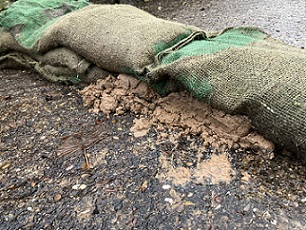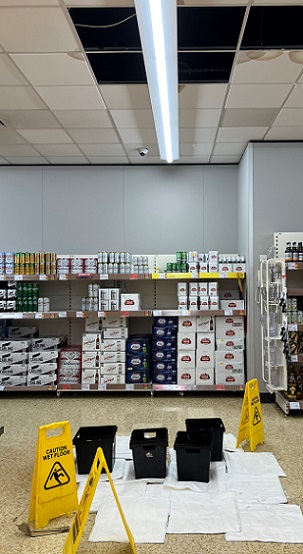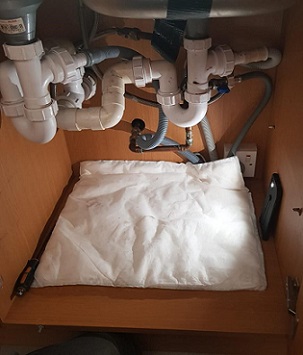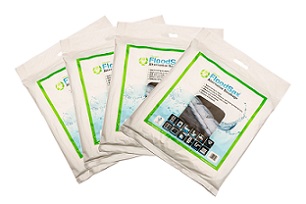 Old-style sandbags often rot when they come into contact with floodwater
Old-style sandbags often rot when they come into contact with floodwater
 All these 20 FloodSax alternative sandbags came from this one easy-to-carry box
All these 20 FloodSax alternative sandbags came from this one easy-to-carry box
 FloodSax alternative sandbags keep their shape and size and can hold back a torrent of floodwater
FloodSax alternative sandbags keep their shape and size and can hold back a torrent of floodwater
 FloodSax can be used to soak up internal leaks to prevent slip hazards, especially in public buildings such as supermarkets
FloodSax can be used to soak up internal leaks to prevent slip hazards, especially in public buildings such as supermarkets
 FloodSax soak up leaking water in the most inaccessible places such as beneath sinks, boilers, radiators and even floorboards
FloodSax soak up leaking water in the most inaccessible places such as beneath sinks, boilers, radiators and even floorboards
 FloodSax come in vacuum-packed bags of 5 so are space-saving to store
FloodSax come in vacuum-packed bags of 5 so are space-saving to store
The unpalatable truth about the high cost of pallets of sandbags and why FloodSax alternative sandbags are far more effective, cheaper and multipurpose
It’s an unpalatable truth but sandbags on pallets are absolutely not the way to go when dealing with flooding.
Far too many people still naturally think of prefilled sandbags if flooding is imminent but they are expensive, difficult to get hold of and can quickly deteriorate and spill sand all over the place once they come into contact with floodwater.
Oh, and local councils have absolutely no responsibility to provide them so don’t expect them to come running with sandbags for you in a flooding emergency.
Sandbags are so heavy they’re normally shifted around on pallets and you’ll need a pallet for 20 sandbags whereas 20 FloodSax sandless sandbags fit into a box that one person can easily carry and pop into the boot of a car. You can fit at least 120 FloodSax into an estate car’s boot. You’ll need a lorry to shift that number of sandbags.
We’ve also looked into the cost of prefilled sandbags and they are way more expensive than Floodsax.
People asking ‘how much are sandbags?’ are in for a shock as prefilled sandbags now cost up to £390 for 70 while a box of 20 FloodSax costs around £140 including free express delivery.
We’ve also seen 30 filled polypropylene sandbags costing £218 from a major DIY supplier.
Also be warned that a lot of these old-style sandbags are also way smaller than Floodsax, weighing just 15kg or even 10kg compared to FloodSax which are around 20kg when fully activated. FloodSax are also a uniform shape, unlike sandbags, so are far easier to stack than plastic-coated or hessian-coated sandbags to make robust barriers strong enough to stop a torrent of floodwater.
Sandbags can also quickly deteriorate, fall apart and spill sand. One sandbag company even admits on its website: “Hessian sandbags eventually rot away. Due to their relatively short lifespan, our hessian sandbags are filled to order and we recommend using them within 4 to 6 weeks.”
FloodSax are vacuum-packed so have a shelf life of at least 5 years and will remain effective for around 3 months and probably a lot longer.
Unlike sandbags, FloodSax are multi-use and multi-purpose. They are incredibly space-saving to store as they are vacuum-packed and in their dry state are ultra-flat with a large surface area which makes them ideal to soak up drips, leaks and spills indoors, especially in hard-to-reach places such as beneath boilers, below radiators and underneath pipes.
But immerse them in water and the gelling polymer inside absorbs the water and then retains it, making the FloodSax miraculously inflate to become an instant sandbag but without any sand.
A box of 20 FloodSax are available from £140 including delivery from FloodSax Express https://floodsaxexpress.com/ which aims to provide a next-day delivery service.
You’d need at least 20 FloodSax to protect a couple of doors and airbricks for most homes but the recommendation is two boxes so you have enough to stop floodwater getting into patio doors and garages too. That’s £280 including delivery, still more than £100 cheaper than traditional prefilled sandbags from some companies. Their sandbags are also smaller than FloodSax so you’d need even more to try to keep the water out.
Flood experts all agree that traditional sandbags simply don’t work.
The Environment Agency states: “Sandbags are relatively ineffective when compared to purpose-built flood protection products. We strongly encourage people to use these products.”
The Environment Agency also warns that local councils have no responsibility to provide sandbags or any other flood protection, adding: “Don’t assume the authorities will provide you with sandbags in a flood emergency. It is the responsibility of property owners to take appropriate action to protect their property from flooding.”
UK flood expert Mary Dhonau, director of MDA Flood Resilience Consultants and leader of the Know Your Risk Flood Campaign, says: “Sandbags do more harm than good and it frustrates and upsets me to see them continually being used as a go-to solution when they simply don’t work.
“Whenever a flood is imminent, everyone at risk calls for the inefficient and environmentally unfriendly sandbag which I consider to be no more than a ‘comfort blanket’ when a flood emergency happens.
“In a test at an accredited British Standards Institute testing tank four sandbags placed in front of a household door failed after just 59 seconds of the water being turned on while 10 sandbags held water back for just over two minutes.
“The sand that escaped from the bag badly blocked the sump pump used to drain water out of the testing tank. This also happens in real flood conditions and sand often collects in drains afterwards, rendering them inefficient come the next heavy rainfall.”
FloodSax passed all tests under similar conditions and, as they don’t contain any sand, there’s no danger of them clogging up drains. They are also largely biodegradable by weight making them far more environmentally friendly than traditional sandbags.
Local councils don’t like sandbags either.
Rossendale Council in Lancashire says: “Sandbags are relatively ineffective when compared to purpose-designed flood protection products. As a result, we strongly encourage people to use purpose-made flood protection products.
“Sandbags have disadvantages. During an emergency sufficient quantities may be difficult to obtain, they are time-consuming to lay properly and can be difficult to handle, particularly for the elderly or infirm. The sacking material is biodegradable and will disintegrate if left in place for long periods of time.”
FloodSax were devised by Yorkshire-based Environmental Defence Systems Ltd and around 3 million have now been sold worldwide.
For more information on FloodSax go to www.floodsax.co.uk
Floodsax Vs Traditional Sandbags
Sandbags
- Must be replaced regularly costing thousands of pounds for big companies and local authorities that need palletised sandbags ready all year round for any emergency.
- Can deteriorate if stored for a long time, especially in cold, damp warehouses.
- Exceptionally unwieldy to lift and handle with all kinds of health, safety and manual handling technique problems for staff who have to use them for flood mitigation at businesses.
- Messy with the sand easily washed out and adding to all the damage if they burst and clog up drains.
- Difficult and expensive to transport anywhere due to their weight. One box of 20 FloodSax is equal to 20 sandbags on a pallet.
- Need a lot of people to move any number of sandbags anywhere and then build them into flood barriers.
- Pre-filled sandbags are expensive and can be difficult to get hold of in an emergency.
Floodsax
- Easy to store and vacuumed-packed to save even more room.
- Multi-purpose and flexible, unlike sandbags. In their dry state FloodSax can be slipped into hard-to-reach places such as beneath pipes and boilers to soak up leaks, drips and spills. Traditional sandbags are, well, just sandbags.
- Always there for peace of mind. No panic to buy sandbags if a flood is forecast.
- Can be expanded in water right next to where you need them and stay taut until the flood subsides so are ideal as strong and robust flood barriers.
- Lightweight before they are used with the standard bag weighing just under 1lb (0.37 kilos) so can be used by people who would not be able to lift sandbags.
- Hundreds can be quickly transported in a van, saving on fuel, wages and manpower. Around 35 boxes with 20 FloodSax in each can fit in a van. That’s 700 Floodsax in all and the same amount of traditional sandbags would weigh 14 tonnes and need lorries to transport them..
- Can be stored in small depots around the area, not one huge central store, so can be taken even more quickly to the scene.
- One can be expanded and put down the toilet to block it from filthy water being forced up by the floodwater backing up through the drains and sewer.
- FloodSax don’t need sand – one of the earth’s natural resources – and so saves the environment.
- FloodSax are largely biodegradable by weight.